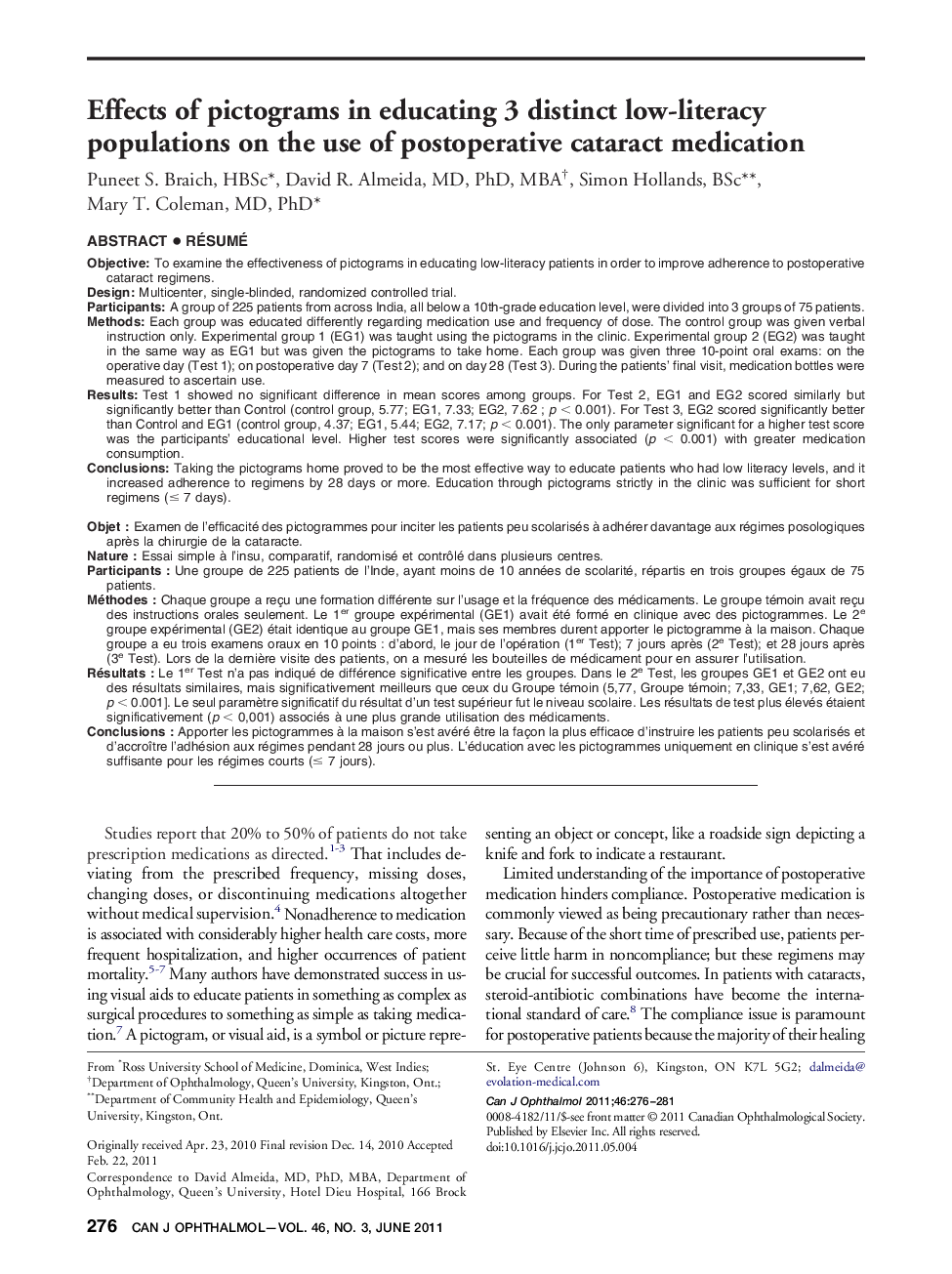| کد مقاله | کد نشریه | سال انتشار | مقاله انگلیسی | نسخه تمام متن |
|---|---|---|---|---|
| 4009824 | 1602423 | 2011 | 6 صفحه PDF | دانلود رایگان |

ObjectiveTo examine the effectiveness of pictograms in educating low-literacy patients in order to improve adherence to postoperative cataract regimens.DesignMulticenter, single-blinded, randomized controlled trial.ParticipantsA group of 225 patients from across India, all below a 10th-grade education level, were divided into 3 groups of 75 patients.MethodsEach group was educated differently regarding medication use and frequency of dose. The control group was given verbal instruction only. Experimental group 1 (EG1) was taught using the pictograms in the clinic. Experimental group 2 (EG2) was taught in the same way as EG1 but was given the pictograms to take home. Each group was given three 10-point oral exams: on the operative day (Test 1); on postoperative day 7 (Test 2); and on day 28 (Test 3). During the patients' final visit, medication bottles were measured to ascertain use.ResultsTest 1 showed no significant difference in mean scores among groups. For Test 2, EG1 and EG2 scored similarly but significantly better than Control (control group, 5.77; EG1, 7.33; EG2, 7.62 ; p < 0.001). For Test 3, EG2 scored significantly better than Control and EG1 (control group, 4.37; EG1, 5.44; EG2, 7.17; p < 0.001). The only parameter significant for a higher test score was the participants' educational level. Higher test scores were significantly associated (p < 0.001) with greater medication consumption.ConclusionsTaking the pictograms home proved to be the most effective way to educate patients who had low literacy levels, and it increased adherence to regimens by 28 days or more. Education through pictograms strictly in the clinic was sufficient for short regimens (≤ 7 days).
RésuméObjetExamen de l'efficacité des pictogrammes pour inciter les patients peu scolarisés à adhérer davantage aux régimes posologiques après la chirurgie de la cataracte.NatureEssai simple à l'insu, comparatif, randomisé et contrôlé dans plusieurs centres.ParticipantsUne groupe de 225 patients de l'Inde, ayant moins de 10 années de scolarité, répartis en trois groupes égaux de 75 patients.MéthodesChaque groupe a reçu une formation différente sur l'usage et la fréquence des médicaments. Le groupe témoin avait reçu des instructions orales seulement. Le 1er groupe expérimental (GE1) avait été formé en clinique avec des pictogrammes. Le 2e groupe expérimental (GE2) était identique au groupe GE1, mais ses membres durent apporter le pictogramme à la maison. Chaque groupe a eu trois examens oraux en 10 points : d'abord, le jour de l'opération (1er Test); 7 jours après (2e Test); et 28 jours après (3e Test). Lors de la dernière visite des patients, on a mesuré les bouteilles de médicament pour en assurer l'utilisation.RésultatsLe 1er Test n'a pas indiqué de différence significative entre les groupes. Dans le 2e Test, les groupes GE1 et GE2 ont eu des résultats similaires, mais significativement meilleurs que ceux du Groupe témoin (5,77, Groupe témoin; 7,33, GE1; 7,62, GE2; p < 0.001]. Le seul paramètre significatif du résultat d'un test supérieur fut le niveau scolaire. Les résultats de test plus élevés étaient significativement (p < 0,001) associés à une plus grande utilisation des médicaments.ConclusionsApporter les pictogrammes à la maison s'est avéré être la façon la plus efficace d'instruire les patients peu scolarisés et d'accroître l'adhésion aux régimes pendant 28 jours ou plus. L'éducation avec les pictogrammes uniquement en clinique s'est avéré suffisante pour les régimes courts (≤ 7 jours).
Journal: Canadian Journal of Ophthalmology / Journal Canadien d'Ophtalmologie - Volume 46, Issue 3, June 2011, Pages 276–281